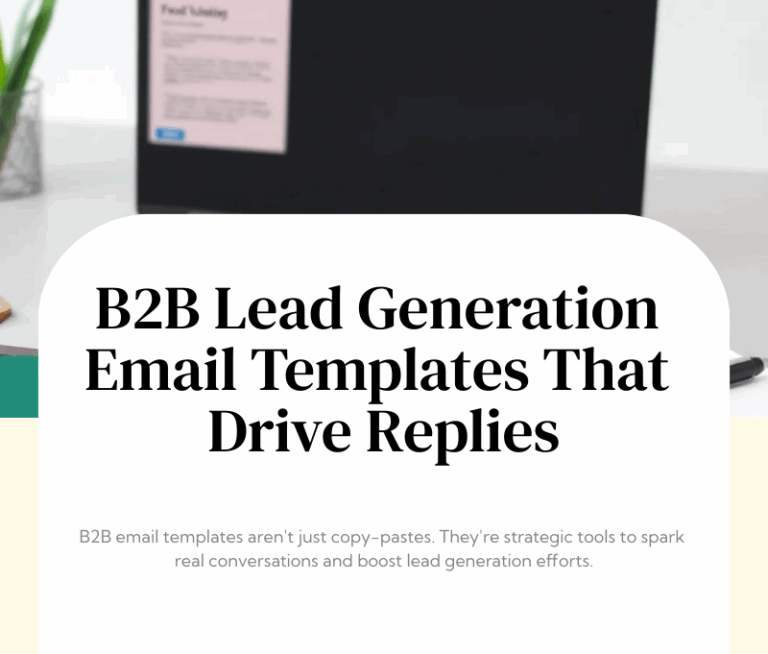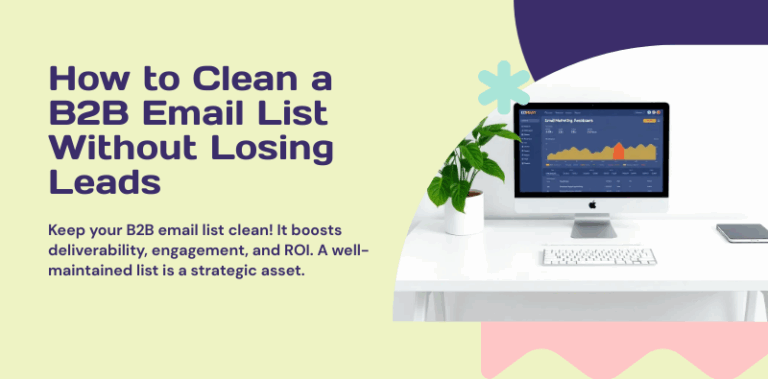

B2B sales professionals are constantly seeking innovative methods to generate quality leads and close high-value deals. The days of cold calling and generic outreach are fading, replaced by sophisticated lead generation techniques tailored to attract, engage, and convert top-tier prospects. To succeed, businesses must adapt their sales strategies to build more personalized and effective connections with their audience.
Whether you’re a seasoned sales executive or a business looking to boost revenue through lead generation, this guide outlines essential techniques for modernizing your B2B sales efforts. By leveraging cutting-edge tools, focusing on customer insights, and refining your approach, you’ll be well on your way to revamping your B2B sales pipeline.
Understanding the Importance of Quality Lead Generation in B2B Sales
Generating leads isn’t just about building a list of potential contacts—it’s about creating connections that have the potential to translate into high-value deals. Quality lead generation prioritizes prospects most likely to benefit from your products or services, thus increasing the chance of successful conversions. By focusing on leads that match your ideal customer profile, your sales team can use their time more efficiently, resulting in a higher return on investment (ROI).
Benefits of Targeted Lead Generation
- Increased Efficiency: By focusing on high-value leads, sales teams can concentrate on prospects with a greater potential for conversion, improving the sales cycle.
- Better Customer Relationships: Identifying quality leads allows sales teams to tailor their approaches to the needs of specific clients, fostering better relationships.
- Higher Conversion Rates: Leads generated through targeted efforts often have a greater interest and alignment with your offerings, resulting in improved conversion rates.
Define and Refine Your Ideal Customer Profile (ICP)
A strong B2B sales strategy begins with a clear understanding of who you’re targeting. An Ideal Customer Profile (ICP) is a detailed description of the type of company that would benefit most from your product or service. A well-defined ICP focuses your lead generation efforts on businesses that are likely to yield high-value deals.
Steps to Develop an Effective ICP
- Analyze Your Best Customers: Identify the characteristics of your top clients—industry, company size, pain points, and goals.
- Leverage Data: Use CRM tools and data analytics to gain insights into customer behaviors, purchase patterns, and common objections.
- Incorporate Sales Team Feedback: Your sales team interacts directly with clients, so their input on what defines a quality lead is invaluable.
- Regularly Update Your ICP: As your business evolves, your ICP should too. Continuously refine your profile to stay aligned with market trends and customer needs.
Use Content Marketing to Attract High-Value Leads
Content marketing is a powerful tool for drawing in quality leads by providing valuable information that resonates with your target audience. The key to success is creating content that addresses specific challenges and showcases your expertise in solving them.
Types of Content for Lead Generation
- White Papers and Ebooks: In-depth resources that provide solutions to industry challenges, establishing your business as a thought leader.
- Case Studies: Demonstrate real-world success stories of how your product or service solved a client’s problem, proving the value of your offerings.
- Webinars and Live Demos: Interactive events that allow prospects to experience your solutions firsthand, increasing engagement and interest.
- Blog Articles: SEO-optimized blog posts attract organic traffic to your website, offering insights on topics relevant to your audience’s pain points.
Content Marketing Best Practices
- Optimize for SEO: Incorporate high-value keywords naturally within your content to improve your search engine ranking.
- Address Common Pain Points: Create content that speaks to the challenges your target audience faces, offering actionable solutions.
- Include Strong Calls-to-Action (CTAs): Encourage readers to take the next step, such as downloading an ebook, signing up for a newsletter, or requesting a demo.

Leverage Account-Based Marketing (ABM) for Personalized Outreach
Account-Based Marketing (ABM) allows you to target specific accounts with tailored messaging, making it a powerful approach for B2B sales. By focusing on high-value prospects, ABM enables you to create personalized experiences that resonate with individual decision-makers.
How to Implement ABM Successfully
- Identify Target Accounts: Start by selecting accounts that align with your ICP and have a high potential for conversion.
- Create Custom Content: Develop content that addresses the unique needs and challenges of each account, from personalized emails to custom landing pages.
- Align Sales and Marketing Efforts: ABM requires close collaboration between sales and marketing teams to ensure messaging is consistent and effective.
- Measure and Optimize: Use analytics to track the performance of your ABM campaigns and make adjustments based on data insights.
Utilize CRM and Sales Automation Tools
Customer Relationship Management (CRM) and sales automation tools streamline your lead generation process, enabling you to track and nurture leads more effectively. These tools help manage interactions with prospects, ensuring timely follow-ups and relevant communications that build stronger relationships.
Key CRM and Automation Tools for B2B Sales
- CRM Platforms: Tools like Salesforce and HubSpot help organize customer information, track sales activities, and manage follow-ups.
- Email Automation: Use email automation to nurture leads with targeted messages based on their interactions with your content.
- Lead Scoring: Assign scores to leads based on their behavior, allowing your sales team to prioritize prospects with higher conversion potential.
- Analytics and Reporting: CRM platforms provide insights into campaign performance, helping you make data-driven decisions to optimize your strategy.
Implement Social Selling Strategies
Social selling leverages social media platforms to connect with potential leads and build relationships that eventually lead to sales. In B2B sales, LinkedIn is particularly effective for reaching decision-makers and sharing content that highlights your expertise.
Best Practices for Social Selling
- Optimize Your Profile: Make sure your profile highlights your expertise and includes keywords that make it easy for prospects to find you.
- Share Relevant Content: Post articles, case studies, and other content that showcases your industry knowledge and addresses potential clients’ pain points.
- Engage with Prospects: Join conversations by commenting on posts, participating in relevant groups, and connecting with prospects who fit your ICP.
- Leverage LinkedIn Sales Navigator: Use LinkedIn’s premium tool to identify and connect with leads who match your ideal customer profile.
Nurture Leads with Targeted Email Campaigns
Email marketing is a staple in B2B sales lead generation, allowing you to stay in touch with prospects and move them through the sales funnel. A successful email campaign is personalized, informative, and strategically timed to keep your brand top-of-mind.
Tips for Effective Email Campaigns
- Segment Your Audience: Divide your email list based on industry, job role, or stage in the buyer’s journey to send more relevant content.
- Personalize Your Emails: Use the recipient’s name and company information to make your emails feel more targeted and less generic.
- Offer Valuable Content: Provide resources such as industry reports, product updates, or case studies that deliver real value.
- Include Clear CTAs: Each email should have a call-to-action, whether it’s to schedule a call, download a resource, or visit a landing page.
Qualify Leads with Discovery Calls
Not every lead is ready to make a purchase, which is why qualifying leads through discovery calls is essential. These calls help you understand the prospect’s needs, challenges, and budget, allowing you to determine whether they’re a good fit for your solutions.
Conducting a Successful Discovery Call
- Ask Open-Ended Questions: Encourage the prospect to share information about their goals, challenges, and expectations.
- Listen Actively: Take note of the prospect’s pain points and align your responses to demonstrate how your product can help.
- Assess Fit and Interest: Determine whether the prospect aligns with your ICP and if they’re genuinely interested in pursuing a solution.
- Provide a Clear Next Step: If the lead is qualified, schedule a follow-up call or demo to move the conversation forward.

Use Data Analytics to Refine Your Strategy
Data-driven decision-making is crucial for optimizing your B2B sales lead generation efforts. By analyzing performance metrics, you can identify areas for improvement and make adjustments to your strategy based on concrete insights.
Essential Metrics for B2B Sales
- Lead Conversion Rate: Track the percentage of leads that convert into customers to gauge the effectiveness of your lead generation tactics.
- Customer Acquisition Cost (CAC): Calculate the cost of acquiring a new customer to ensure your strategy is cost-effective.
- Sales Cycle Length: Monitor how long it takes to close a deal, and look for ways to shorten the sales cycle through improved targeting and nurturing.
- Lifetime Value (LTV): Measure the total revenue generated from a customer over the course of your relationship to prioritize high-value leads.
Adapt and Evolve with Industry Trends
The B2B sales landscape is constantly evolving, and staying ahead of industry trends is essential to maintaining a competitive edge. Regularly review your lead generation and sales strategies to ensure they align with the latest technologies, buyer behaviors, and market conditions.
Staying Ahead of the Curve
- Invest in Training: Regularly train your sales team on new tools, techniques, and industry best practices to keep their skills sharp.
- Attend Industry Events: Conferences and webinars offer valuable insights into emerging trends and networking opportunities with potential clients.
- Monitor Competitors: Keep an eye on what your competitors are doing and look for ways to differentiate your approach.
- Embrace New Technology: From AI-driven analytics to sales automation, adopting the latest tools can give your sales team an edge.
Emphasizing Relationship Building for Long-Term Success
In B2B sales, building and maintaining strong relationships with clients is crucial for closing high-value deals and fostering long-term success. Unlike B2C sales, where purchases are often transactional, B2B sales require trust, reliability, and consistent value delivery. Here are some relationship-building strategies to help B2B sales professionals cultivate deeper connections with potential clients:
1. Prioritize Transparency and Honesty
Transparency is essential in building trust. Be upfront about your offerings, limitations, and pricing. This approach fosters respect and sets realistic expectations, reducing the chances of misunderstandings down the road. Honesty about what your product can and cannot do strengthens credibility, and clients will appreciate the openness when assessing whether your solution aligns with their needs.
2. Invest Time in Personalized Follow-Ups
Post-sales follow-ups are just as important as initial outreach. A well-timed, personalized follow-up shows prospects that they are valued beyond their role as potential customers. After a meeting or discovery call, send a summary of the conversation, addressing their pain points and outlining how your product or service can help. These follow-ups demonstrate attentiveness and ensure that prospects have all the information needed to make informed decisions.
3. Demonstrate Value Through Continued Engagement
Continued engagement through newsletters, personalized emails, or invitations to webinars can help maintain contact with prospects over time. Rather than pushing for a sale immediately, provide valuable content that aligns with their interests and addresses their challenges. For example, share insights on industry trends, new tools, or ways to maximize your product’s benefits. This approach positions your company as a trusted partner rather than just a vendor.
Leveraging Social Proof to Build Credibility
In the B2B landscape, decision-makers are often risk-averse, seeking assurance that they’re making the right choice. Social proof—such as testimonials, case studies, and industry certifications—can provide that assurance by showing evidence of your past successes.
1. Showcase Case Studies and Success Stories
Case studies are a compelling way to demonstrate the effectiveness of your solutions. Highlight specific examples of how your products or services solved a client’s problem, detailing the process and the results. By presenting measurable outcomes, such as a percentage increase in efficiency or revenue, you give potential clients concrete proof of your value. Remember to focus on cases that are relatable to your target audience’s industry or business size for maximum impact.
2. Gather and Share Client Testimonials
Testimonials from satisfied clients build trust with potential customers by validating your claims. Display testimonials on your website, in marketing materials, and on social media to increase credibility. Whenever possible, use testimonials from recognizable brands or well-known figures within your industry to further strengthen your reputation.
3. Leverage Industry Accolades and Certifications
Industry accolades, certifications, and partnerships reflect a commitment to quality and can give you an edge over competitors. These credentials signal to potential clients that your business meets high standards and is respected in the marketplace. Display these accolades prominently on your website and in your sales materials, especially if they are specific to the industries you serve.

Adapting Your Strategy with the Buyer’s Journey in Mind
Understanding the buyer’s journey—a prospect’s path from initial awareness to final decision—is essential for developing a B2B sales strategy that resonates at each stage. A customer-centric approach tailored to where the prospect is in their journey can significantly enhance lead generation and conversion rates.
1. Awareness Stage: Educate and Inform
In the awareness stage, prospects are identifying problems and seeking general solutions. Your goal is to educate them on the challenges they face and position your company as a knowledgeable resource. Use blog posts, white papers, and informational videos to discuss common pain points and introduce your expertise. Avoid pushing sales at this stage; instead, focus on providing value through insights and information.
2. Consideration Stage: Provide Specific Solutions
When a prospect enters the consideration stage, they are evaluating different solutions to address their problem. Now is the time to present your product or service as a potential fit. Case studies, product comparison sheets, and webinars can be useful tools to showcase how your solution meets their specific needs. Personalizing the content to address the unique challenges the prospect faces will help build a strong case for your offerings.
3. Decision Stage: Address Concerns and Offer Assurance
In the decision stage, prospects are ready to make a purchase but may have final reservations. Offering one-on-one consultations, product demos, or trials can help address any last-minute concerns. This is also the stage where providing social proof, such as client testimonials or ROI projections, can help seal the deal. Offering flexible payment terms or a money-back guarantee can also provide additional assurance, demonstrating your confidence in your product’s value.
Focusing on Continuous Improvement
The B2B sales landscape is dynamic, requiring an adaptive approach. Regularly assess and refine your lead generation strategies based on performance data, feedback from the sales team, and customer interactions. Here are some steps for ongoing improvement:
- Encourage Team Feedback: Sales teams are on the front lines, interacting with prospects and closing deals. Regularly solicit their insights on what’s working and where there are opportunities for improvement.
- Conduct Regular Training: Investing in training on new sales techniques, tools, and industry trends ensures your team stays equipped to handle an evolving marketplace.
- Utilize Analytics for Informed Decision-Making: Track key performance metrics—such as lead conversion rates, customer acquisition costs, and sales cycle length—to gauge the effectiveness of your strategies and pinpoint areas for improvement.
- Experiment and Iterate: Don’t be afraid to test new tactics, whether it’s trying out a new sales tool, adopting a different outreach approach, or revamping your content strategy. By staying flexible and willing to experiment, you’ll discover new ways to generate leads and close high-value deals.



